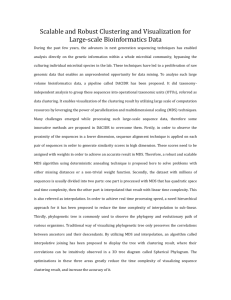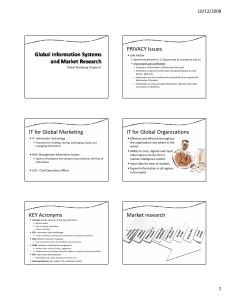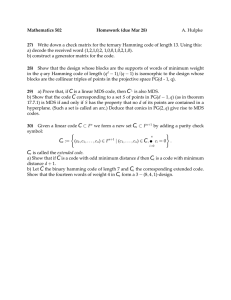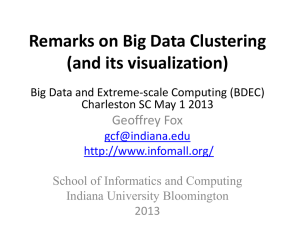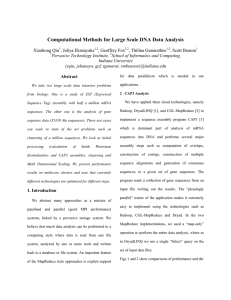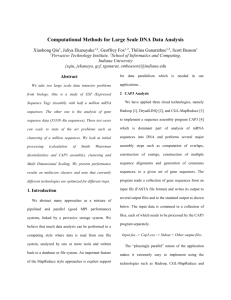Case Studies in Data Intensive Computing: Large Scale DNA Sequence
advertisement
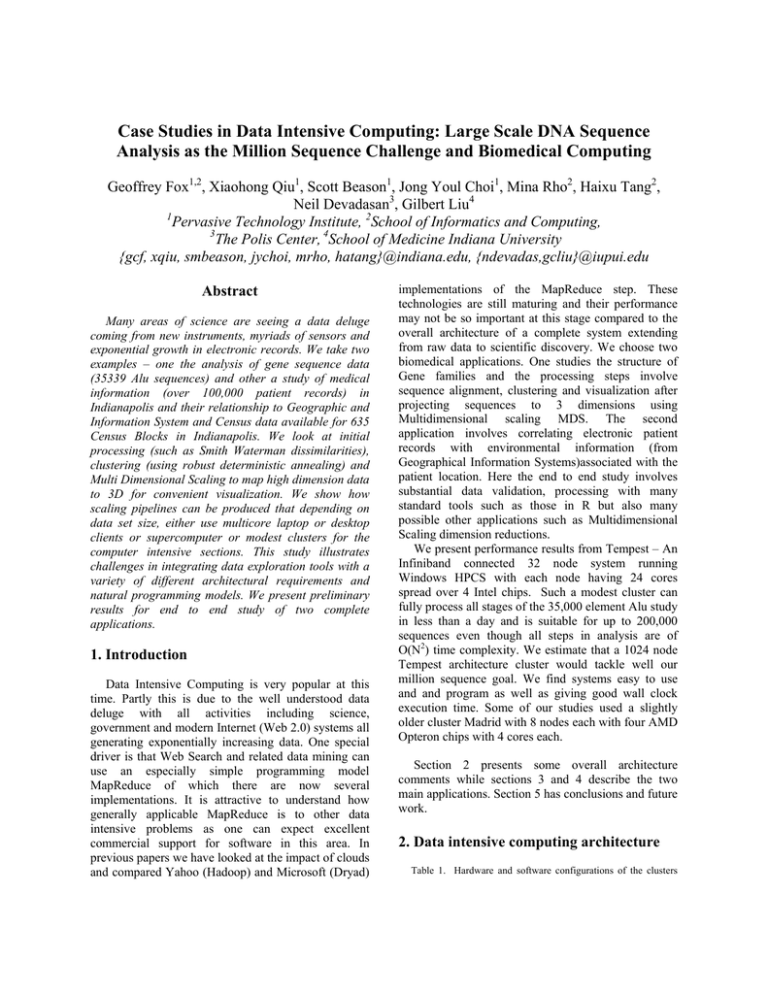
Case Studies in Data Intensive Computing: Large Scale DNA Sequence
Analysis as the Million Sequence Challenge and Biomedical Computing
Geoffrey Fox1,2, Xiaohong Qiu1, Scott Beason1, Jong Youl Choi1, Mina Rho2, Haixu Tang2,
Neil Devadasan3, Gilbert Liu4
1
Pervasive Technology Institute, 2School of Informatics and Computing,
3
The Polis Center, 4School of Medicine Indiana University
{gcf, xqiu, smbeason, jychoi, mrho, hatang}@indiana.edu, {ndevadas,gcliu}@iupui.edu
Abstract
Many areas of science are seeing a data deluge
coming from new instruments, myriads of sensors and
exponential growth in electronic records. We take two
examples – one the analysis of gene sequence data
(35339 Alu sequences) and other a study of medical
information (over 100,000 patient records) in
Indianapolis and their relationship to Geographic and
Information System and Census data available for 635
Census Blocks in Indianapolis. We look at initial
processing (such as Smith Waterman dissimilarities),
clustering (using robust deterministic annealing) and
Multi Dimensional Scaling to map high dimension data
to 3D for convenient visualization. We show how
scaling pipelines can be produced that depending on
data set size, either use multicore laptop or desktop
clients or supercomputer or modest clusters for the
computer intensive sections. This study illustrates
challenges in integrating data exploration tools with a
variety of different architectural requirements and
natural programming models. We present preliminary
results for end to end study of two complete
applications.
1. Introduction
Data Intensive Computing is very popular at this
time. Partly this is due to the well understood data
deluge with all activities including science,
government and modern Internet (Web 2.0) systems all
generating exponentially increasing data. One special
driver is that Web Search and related data mining can
use an especially simple programming model
MapReduce of which there are now several
implementations. It is attractive to understand how
generally applicable MapReduce is to other data
intensive problems as one can expect excellent
commercial support for software in this area. In
previous papers we have looked at the impact of clouds
and compared Yahoo (Hadoop) and Microsoft (Dryad)
implementations of the MapReduce step. These
technologies are still maturing and their performance
may not be so important at this stage compared to the
overall architecture of a complete system extending
from raw data to scientific discovery. We choose two
biomedical applications. One studies the structure of
Gene families and the processing steps involve
sequence alignment, clustering and visualization after
projecting sequences to 3 dimensions using
Multidimensional scaling MDS. The second
application involves correlating electronic patient
records with environmental information (from
Geographical Information Systems)associated with the
patient location. Here the end to end study involves
substantial data validation, processing with many
standard tools such as those in R but also many
possible other applications such as Multidimensional
Scaling dimension reductions.
We present performance results from Tempest – An
Infiniband connected 32 node system running
Windows HPCS with each node having 24 cores
spread over 4 Intel chips. Such a modest cluster can
fully process all stages of the 35,000 element Alu study
in less than a day and is suitable for up to 200,000
sequences even though all steps in analysis are of
O(N2) time complexity. We estimate that a 1024 node
Tempest architecture cluster would tackle well our
million sequence goal. We find systems easy to use
and and program as well as giving good wall clock
execution time. Some of our studies used a slightly
older cluster Madrid with 8 nodes each with four AMD
Opteron chips with 4 cores each.
Section 2 presents some overall architecture
comments while sections 3 and 4 describe the two
main applications. Section 5 has conclusions and future
work.
2. Data intensive computing architecture
Table 1. Hardware and software configurations of the clusters
used in this paper. In addition a traditional 8-node Linux Cluster
“Gridfarm” was used to run statistics package R in section 4.
System/ Size Tempest 32 Cluster + 1 Head CPU Memory 4 Intel Six CoreXenon E7450 2.4 GHz Cluster:48 GB Head: 24 GB 12 MB Cache 4 AMD Quad Core. Opteron 8356 2.3GHz Cluster:16 GB Head: 8 GB 2 MB Cache Operating System Windows Server 2008 HPC Ed. (SP1) Network
1 Gbps
Ethernet Pairwise
clustering
FASTA File
Alu Sequences
Windows Server HPC Ed. (SP1) 20Gbps Infiniband
The computer architecture needed to support data
intensive computing is obviously complex and varied.
Here we do not discuss virtualization or issues of
distributed systems which although important are not
the topic of this paper. We abstract many approaches
as a mixture of pipelined and parallel (good MPI
performance) systems, linked by a pervasive storage
system. Here we have many interesting possibilities
including Amazon and Azure “Blob” storage,
traditional supercomputer environment like Lustre plus
importantly the file systems (such as Cosmos from
Microsoft or HDFS from Hadoop) supporting the new
MapReduce systems.
Database
Instruments
Database
Files
Files
Database
Files
Visualization
User Portal
Knowledge
Discovery
User Data
Database
Users
Database
Files
Files
Database
Files
Database
Database
Database
Files
Files
Files
Initial
Processing
Higher Level Processing
(e.g. R, PCA, Clustering
Correlations)
maybe MPI
Prepare for
Visualization
(e.g. MDS)
Figure 1. A Data intensive computing architecture
These cloud/Web 2.0 technologies support a
computing style where data is read from one file
system, analyzed by one or more tools and written
back to a database or file system. An important feature
of the newer approaches is explicit support for data
parallelism which is needed in our applications.
In figure 1, we abstract this disc/database-compute
model and assume it will underlie many applications
even when some of resources will be local and others
in the cloud or part of a large grid. In figures 3 and 2
we give in more detail the data pipelines used in the
applications of sections 3 and 4 respectively.
Finally we record in table 1, the major facilities
used in this study. Note they run Windows (HPC
Edition) and stress both multicore and traditional
parallelism.
Sequence
alignment
Visualization
Plotviz
Dissimilarity
Matrix
(624,404,791
values)
MDS
Figure 2. Stages of Gene sequencing application
Health Data
Madrid 8 Cluster + 1 Head Blocking
(35339)
Form
block
Pairings
validating
regrouping
Subblock
groups
PCA
R
CCA
PC data
CCA vectors
distance
MDS
Visualization
Plotviz
Figure 3. Stages of health application
The largest Tempest cluster has 768 Intel Cores spread
over 32 nodes while the smaller one Madrid has 128
Opteron cores spread over 8 nodes. Our work [5, 19,
21] stresses both Windows and Linux so we can
explore Hadoop, Dryad and the emerging cloud
approaches. This paper focuses on results from the
Windows clusters.
3. Gene Sequencing Applications
3.1. Alu Sequencing Studies
The Alu clustering problem [13] is one of the most
challenging problem for sequencing clustering because
Alus represent the largest repeat families in human
genome. There are about 1 million copies of Alu
sequences in human genome, in which most insertions
can be found in other primates and only a small
fraction (~ 7000) are human-specific insertions. This
indicates that the classification of Alu repeats can be
deduced solely from the 1 million human Alu
elements. Notable, Alu clustering can be viewed as a
classical case study for the capacity of computational
infrastructures because it is not only of great biological
interests, but also a problem of a scale that will remain
as the upper limit of many other clustering problem in
bioinformatics for the next few years, e.g. the
automated protein family classification for a few
millions of proteins predicted from large
metagenomics projects.
3.2. Smith Waterman Dissimilarities
The first step is to identify human Alu gene
sequences which were obtained by using Repeatmasker
[14] with Repbase Update [15]. We have been
gradually increasing the size of our projects with the
current sample having 35339 sequences the largest and
requires a modest cluster such as Tempest (768 cores).
Note from the discussion in section 3.1, we are aiming
at supporting problems with a a million sequences -quite practical today on TeraGrid and equivalent
facilities given basic analysis steps scale like O(N2).
We used open source version [16] of the Smith
Waterman – Gotoh algorithm SW-G [17, 18] modified
to ensure low start up effects by each thread/processing
large numbers (above a few hundred) at a time.
Memory bandwidth needed was reduced by storing
data items in as few bytes as possible.
3.2.1 Performance of Smith Waterman Gotoh
SW-G Algorithm
The calculation of the 624 million independent
dissimilarities is of course architecturally simple as
each computation is independent. Nevertheless it
shows striking structure shown in figure 4. As in
previous papers, we look at different patterns denoted a
(Thread per process) x (MPI process per 24 core node)
x (Number of Nodes). In pattern txmxn. We have for
Tempest defined in table 1, n <=32 and txm <= 24. We
present results in terms of parallel overhead f(P)
defined for Parallelism P by
f(P) = [PT(P) –T(1)] /T(1)
Figure 5. Paging and Context Switching for a pure Threaded SW-G
(1)
Where T(1) is replaced in practice by T(on smallest
number of processes that can run job).
Figure 6: Paging and Context Switching for an MPI SW-G
This could lead to a slow down of threaded approach
and correspond to Windows handing of paging of
threads with large memory footprints. However there is
also an important data transfer effect that we discuss in
the following subsection.
3.2.2 The O(N2) Factor of 2 and data transfer
Figure 4. Performance of Alu Gene Alignments for different parallel
patterns
The striking result for this step is that MPI easily
outperforms the equivalent threaded version of this
embarrassingly parallel step. In figure 4, all the peaks
in the overhead correspond to patterns with large
values of thread count t. On figure 4, we note that MPI
intranode 1x24x32 pattern completes the full 624
billion alignments in 2.33 hours – 4.9 times faster than
threaded implementation 24x1x32. This 768 core MPI
run has a parallel overhead of 1.43 corresponding to a
speed up of 316.
The SW-G alignment performance is probably
dominated by memory bandwidth issues but we are
still pursuing several points that could effect this but
not at our highest priority as SW-G is not a dominant
step. We have tried to identify the reason for the
comparative slowness of threading. Using Windows
monitoring tools, we see in figures 5 and 6 that
threaded version has about a factor of 100 more
context switches (note different scale factors used) than
case where in MPI we have one thread per process.
There is a well known factor of 2 in many O(N2)
parallel algorithms such as those in direct simulations
of astrophysical stems. We initially calculate in parallel
Distance D(i,j) between points (sequences) i and j and
as discussed above this is done in parallel over all
processor nodes selecting criteria i < j to avoid
calculating both D(i,j) and the identical D(j,i). This can
require substantial file transfer as it is unlikely that
nodes requiring D(i,j) in a later step, will find that it
was calculated on nodes where it is needed.
For example the MDS and PW(PairWise)
Clustering algorithms described in next 2 sections,
require a parallel decomposition where each of N
processes (MPI processes, threads) has 1/N of
sequences and for this subset {i} of sequences stores in
memory D({i},j) for all sequences j and the subset {i}
of sequences for which this node is responsible. This
implies that we need D (i,j) and D (j,i) (which are
equal) stored in different processors/disks). This is a
well known collective operation in MPI called either
gather or scatter. Note that we did NOT get good
performance for data transfer of D(i.j) to its needed
final processor from either MPI (it should be a seconds
on Petabit/sec Infiniband switch) or Dryad. We intend
to make the needed collective (reduction) primitives
more precise and expect substantial performance
improvement. However, for the results presented here
the timings include the I/O necessary to write results
from each process to local disk. An additional step
was necessary in our processing workflow to combine
the results into a single file used in downstream
processing such as clustering and MDS.
is
superior.
3.2.3 Relevance of Hadoop and Dryad
We expected to use Dryad for this initial SW-G
computation and data transfer but were not able to
complete this work in time for this paper. Clearly this
step fits MapReduce very well and as technology and
our experience with it improves [19], we expect to
include Dryad (on Tempest) and Hadoop (Linux)
evaluations here and it is quite likely that they will
deliver preferred implementation.
3.3 Pairwise Clustering
As data sets increase in size, we expect some
applications to require particularly robust algorithms
that are as insensitive as possible to well known
difficulties such as “trapping in local minima”. This
increases computing challenge which grows to
accommodate data set and increase robustness of
results. For example, clustering methods like Kmeans
are very sensitive to false minima but some 20 years
ago a more robust EM (Expectation Maximization)
method using annealing (deterministic not Monte
Carlo) was developed by Ken Rose (UCSB) [1], Fox
and others [4].
Here the annealing is in distance (as represented by
D(i,j) ) resolution. One slowly lowers a Temperature T
that implements an algorithm sensitive to distance
scales of order T0.5. This method has interesting feature
that it automatically splits clusters when instabilities
detected. Further it has a highly efficient parallel
algorithm which we have studied in detail in earlier
papers on smaller problems [5]. These clustering
approaches are fuzzy methods where points are
assigned probabilities for belonging to a particular
cluster. There are striking differences between pattern
dependence of figures 4, 7 and 8. In all cases MPI is
used as communication mechanism between nodes but
we can use any mix of threading and MPI on a single
node. For figure 4 intranode MPI always gave best
performance but in figures 7 and 8, intranode threading
is the best. We have analyzed this in detail elsewhere
and found it is a consequence of MPI communication
overheads that increase as data parallel unit (of size
35339/(m n)) decreases. For large data parallel units
MPI is fastest but for smaller ones used here, threading
Figure 7: Performance of Pairwise Clustering for 4 clusters on
Tempest. 10 Clusters take about 3.5 times longer
The original clustering work was based in a vector
space (like Kmeans) where a cluster is defined by a
vector as its center. However in a major advance 10
years ago [2, 3], it was shown how one could use a
vector free approach and operate with just the distances
D(i,j). This unfortunately does increase the
computational complexity from O(N) to O(N2) for N
sequences. It appears however more natural for studies
of sequences which do not have Euclidean vectors
easily associated with them. We completed these
pairwise vector free algorithms and implemented them
in parallel. We have discussed elsewhere detailed
algorithm and performance issues. Here we report the
clustering as part of a large end to end component of
our “Million Sequence Analysis as a Service project.
All capabilities discussed in this paper will be made
available as cloud or TeraGrid services over next 3-12
months.
3.4 Multidimensional Scaling MDS
Given dissimilarities D(i,j), MDS finds the best set
of vectors xi in any chosen dimension d minimizing
(2)
i,j weight(i,j) (D(i,j) – |xi – xj|n)2
The weight is chosen to reflect importance of point or
perhaps a desire (Sammon’s method) to fit smaller
distance more precisely than larger ones. The index n
is typically 1 (Euclidean distance) but 2 also useful
We have previously reported results using
Expectation Maximization and we are exploring
adding to this deterministic annealing to improve
robustness. Here we use a different technique
exploiting that (2) is “just” 2 and one can use very
reliable nonlinear optimizers to solve it [20]. We have
implemented and got good results with the Levenberg–
Marquardt approach (adding suitable multiple of unit
matrix to nonlinear second derivative matrix) to 2
solution.
Figure 8: Performance of Pairwise Clustering on Tempest
Figure 9: Clustering of Alu Sequences
This “MDS as 2” approach allows us to incorporate
some powerful features including very general choices
for the weight(i,j) and n. Our MDS service is fully
parallel over unknowns xi. Further it allows
“incremental use”; fixing an MDS solution from a
subset of data and adding new points at a later time.
One can also optimally align different versions of
MDS (e.g. different choices of weight(i,j) to allow
precise comparisons. All our MDS services feed their
results directly to powerful Point Visualizer. Figure 9
shows the end to end Alu study after SW-G alignments,
pairwise clustering and MDS projection. One sees
three small clusters red (2794 points), yellow (3666)
and green (1838 sequences) isolated from larger
(27041) collection of blue sequences that are
presumably older. Note that total time for all 3 steps on
the full Tempest system is about 6 hours and clearly
getting to a million sequences is not unrealistic and
would take around a week on a 1024 node cluster.
4. Linking Environment and Health Data
4.1. Introduction
Another area where our tools are naturally used
comes in Geographical information systems where we
have already presented results [21]. Here we link
environmental and patient (health) data. This is
challenging as a community’s vulnerability and impact
may depend on special concerns like environmentally
sensitive areas or historical structures, socioeconomic
conditions, and various social concerns such as the
degree of public trust, education levels, literacy, and
collective action and solidarity. The event impact must
account for a blend of physical and social measures.
One example is the SAVI Community Information
System (www.savi.org)1 is one of the nation’s largest
community information systems [22]. SAVI, designed
to improve decision-making in Central Indiana
communities. SAVI includes over a ~22 million
individual data values, provides over 161,322 event
datasets, 3,099 basic indicators on the socio-economic
conditions, health, economy, housing, and many other
aspects of the community and makes them available
for 11 types of geographic areas, such as census tracts,
neighborhoods, and school corporations. The SAVI
system now is being used by a variety of other sectors
for community development, public health research,
education, program planning, disaster mitigation
planning and more. Only recently has the field of
social epidemiology begun to develop the theoretical
tools that make possible the identification of
explanatory pathways from the physical and social
infrastructure to health-related behaviors, which then
lead to adverse health outcomes [23-25]. We see
geographic clustering in many health outcomes
because social environment has an effect on health
and/or health behaviors [26-28]
4.2. Obesity
We used an ongoing childhood obesity study as our
first application to test the relevance of our tools in the
area of linking environment and social/health data. [67] Obesity is presently one of the most pervasive,
serious, and challenging health problems facing the
world. Over the past 30 years, the obesity rate has
nearly tripled for children ages 2 to 5 years (from 5 to
14 percent) and tripled for youth ages 12 to 19 years
(from 5 percent to 17 percent). The obesity rate for
children 6 to 11 years of age has quadrupled from 4 to
19 percent. What is causing the dramatic and
threatening rise in obesity? Bray concisely captured the
etiology of obesity in metaphor: “Genes load the gun,
the environment pulls the trigger.” 23 Genetic factors
are thought to account for 25-40% of the variance in
BMI (Body Mass Index) by determining differences in
such things as resting metabolic rate and weight gain in
response to overfeeding. However, it is highly
improbable that changes in genetic factors explain the
rapid increases in obesity prevalence over the past two
decades.26 Rather, the obesity epidemic is almost
certainly rooted in environmental factors that promote
excessive caloric intake and sedentary lifestyle [8].
In addition to physical environmental factors, social
environmental factors also have bearing on obesity by
facilitating or constraining behavior. Specific social
environmental factors that have been examined include
crime, safety, social support, social networks, and
neighborhood socioeconomic status. Perceived (or
actual) lack of a safe environment is a significant
barrier to physical activity. According to a study
conducted by the Centers for Disease Control in 2004,
persons who perceived their neighborhoods as less than
extremely safe were more than twice as likely to have
no leisure-time physical activity, and those who
perceived their neighborhoods as not at all safe were
nearly three times as likely to have no leisure-time
physical activity. Research also indicates that parental
concerns about traffic and crime have a strong
influence on children’s physical activity levels and that
child and parent perceptions of the environment are as
important as the actual environment.
This motivates studies that study linkage between
patient health and environment factors.. We can
examine urban planning data that provides information
on characteristics of the built environment, such as
street features, land use mix, and neighborhood
greenness. We examine insurance information from
patient medical records as an indicator of family-level
social environment. We examine U.S. Census and
Uniform Crime Report information for areas
surrounding patients’ residential addresses as
indicators of neighborhood social environment. Here
we are setting up the infrastructure linking the tool R
with our other tools described in section 3 and only
have preliminary results on this use case for a new
generation of large scale data analysis tools. As there
are some 30 patient attributes and over one hundred
environmental attributes, tools like MDS that reduce
dimensionality were our first focus.
4.3. Canonical Correlation Analysis
The canonical correlation analysis (CCA) is a tool
of multivariate statistical analysis for finding
correlations between two sets of variables [9, 10]. We
are applying CCA to study how childhood obesity is
mostly related with what kinds of environmental
factors. Our full data set we used for this research
consists of over 314,000 real-life patient records
collected over 15 years (some records are 20 year old)
and measured on about 180 variables, mostly related
with biological and environmental factors. We stored
our full data set (size of 832 MB) in a database system
for easy exploration and fast extraction. Among the full
data set, we only used the cleanest data for our initial
studies.
For performing CCA over the patient data set and
conducting various kinds of statistical analysis, we
used R, one of the most well-known statistical
computing environments, to expedite complicated
statistical data manipulations with ease and utilize
highly optimized and multi-threaded numeric packages,
such as BLAS, Goto-BLAS [11], and ATLAS [12].
Another advantage in using R is that we can use
various open-source based add-on packages for
additional functionalities. For example, with the help
of packages for databases, such as PostgreSQL and
MySQL, we can directly access the data stored in the
database system. Here we focus on integrating R with
our specialized tools and present initial MDS analysis
here.
4.3. Multi Dimensional Scaling and Visualization
The core of CCA is to find an optimal linear
projection of two sets of data in a sense that the
correlation of them in the projected space, also called
“canonical space”, is maximized. More specifically, for
the given two sets of data matrix X and Y, the CCA
seeks two optimal projection vectors a and b, which
make the following correlation maximum:
cor(U ,V ) ,
where U a X and V b Y are vectors in the
canonical space. One can see that the vector U and V,
known as canonical correlation variables, are the new
representation of the data matrix X and Y in the
canonical space, transformed by the projection vector a
and b respectively. By further investigating U and V as
a product of the CCA, one may infer crossrelationships exist between two sets of variables, which
are not directly available from the row data set.
In our project, the CCA is the best match for our
purpose. We have two sets of data – patient and
environmental data – and want to find out which
variables of environmental data have some connections
to patient’s obesity or more generally health. For this
purpose, we can use X as an environmental data and Y
as a patient data into the CCA to find the best optimal
canonical variables U and V, which maximize the
correlation between the patient and the environmental
data in the canonical space. Figure 10 presents one of
the CCA results on our data set as an example.
As an alternative to CCA, which maximizes vector
in both data sets, one can find the vectors a and b by
using the Principle Component Analysis (PCA) within
a single sector. For an example, with our health data
set, we can find new projection vector a by fixing b in
terms of Principle Components (PC) of the patient data
matrix Y.
Since the well known CCA algorithm itself is not
our focus in this paper, we will not present more details
in As an example of CCA results to the patient data set,
we found the optimal correlation in the canonical space
(Figure 10). Those results can feed in to the MDS to
find more robust structures in 3-dimension (Figure 11).
T
T
Figure 10. The plot of the first pair of canonical variables for 635
Census Blocks
Figures 11(a) and 11(b) show this CCA analysis
projected on an MDS representation of environment
data. this paper. More details can be found in [9, 10].
Each point corresponds to one of 635 Census blocks.
We color projections on a green (lowest) to red/mauve
(highest) scale and see clear clustering of the different
colors in different regions of MDS. The low (green)
values occur together and are well separated from the
high weighted red and mauve points. In these plots the
MDS was weighted (using weight(i,j) in equ. (2)
proportionally to number of patients in block. Figures
11(c) and (d) show correlations for a pure principal
component analysis PCA; this is high for
environmental PCA (as one would expect) but still
present for PCA in patient health space.
In processing CCA in our project, we have used R
as statistical computing environments to utilize various
matrix manipulation and linear algebra packages with
efficiency. Also, by building R with multi-threaded
enabled BLAS libraries, we got parallel speed up in
our 8 core Linux cluster nodes “Gridfarm”. As a result,
we have applied the CCA to our data set with various
parameter settings and visualized them by using our
parallel MDS projection described earlier. Figure 11
illustrate the MDS visualization of PCA and CCA
analyses. This clearly illustrates that correlations can
be seen when projecting societal data on MDS of
environmental information. We are following on with
both obesity and SAVI datasets with different selection
s of environmental data.
Figure 11. MDS visualization of PCA and CCA analyses for
correlations between patient and environmental data described below.
5. Conclusion and Future Work
This paper examines the technology to support
rapid analysis of million sequence problems that
appear to typify today’s high end challenges. As well
as our local sample problems, we would like to refine
and test the technology on a broader range of
problems. To encourage this, we will make key
capabilities available as services that we eventually be
implemented on virtual clusters (clouds) to address
very large problems. This will require work we are
doing now on Hadoop and Dryad – can they be a single
unifying technology? Relevant services we will make
available include the basic Pairwise dissimilarity
calculations, R (done already by us and others), MDS
in EM and 2 forms; the vector and pairwise
deterministic annealing clustering including support of
fingerprints and other ”unusual” vectors. Our point
viewer (Plotviz) will be made available either as
download (to Windows!) or as a Web service. We note
all our current code is written in C# (high performance
managed code) and runs on Microsoft HPCS 2008
(with Dryad extensions)
We’ve shown two examples of data intensive
science applications in area of biology and health using
several modern technologies. We suggest that these
ideas will support new generations of large scale data
analysis systems for patient records, demographic data
and next generation gene sequencers.
6. References
[1] K. Rose, “Deterministic Annealing for Clustering,
Compression, Classification, Regression, and Related
Optimization Problems”, Proceedings of the IEEE, vol. 80,
pp. 2210-2239, November 1998.
[16] Smith Waterman software with Gotoh enhancement
from http://jaligner.sourceforge.net/naligner/.
[2] T Hofmann, JM Buhmann, “Pairwise data clustering by
deterministic annealing”, IEEE Transactions on Pattern
Analysis and Machine Intelligence 19, pp1-13 1997.
[17] Smith, T.F. and Waterman, M.S. 1981. “Identification of
common molecular subsequences”. Journal of Molecular
Biology 147:195-197
[3] Hansjörg Klock and Joachim M. Buhmann, “Data
visualization by multidimensional scaling: a deterministic
annealing approach”, Pattern Recognition, Volume 33, Issue
4, April 2000, Pages 651-669.
[18] Gotoh, O. 1982. “An improved algorithm for matching
biological sequences”. J. of Molecular Biology 162:705-708
[4] Granat, R. A., “Regularized Deterministic Annealing EM
for Hidden Markov Models”, Ph.D. Thesis, UCLA, 2004.
[5] Geoffrey Fox, Seung-Hee Bae, Jaliya Ekanayake,
Xiaohong Qiu, and Huapeng Yuan, “Parallel Data Mining
from Multicore to Cloudy Grids”, Proceedings of HPC 2008,
High Performance Computing and Grids Workshop, Cetraro
Italy, July 3 2008.
[6] Liu G, Wilson J, Rong Q, Ying J., “Green neighborhoods,
food retail, and childhood overweight: differences by
population density”, American Journal of Health Promotion
2007, March/April, V21, I4 Supplement 317-325
[7] Liu G et al.“Examining Urban Environment Correlates of
Childhood Physical Activity and Walkability Perception with
GIS and Remote Sensing”, In: Geo-spatial Technologies in
Urban Environments Policy, Practice, and Pixels. 2nd ed.
Berlin: Springer Verlag; 2007:121-40.
[8] Robert Sandy, Gilbert Liu, et al. “Studying the child
obesity epidemic with natural experiments”, NBER Working
Paper in May 2009. http://www.nber.org/papers/w14989
[9] D. Hardoon et al., “Canonical correlation analysis: an
overview with application to learning methods”, Neural
Computation, 16(12):2639--2664, 2004.
[10] W. Härdle and L. Simar, Applied multivariate statistical
analysis, Springer, 2007. Pages 361-372
[11] K. Goto and R. Van De Geijn, “High-performance
implementation of the level-3 blas”, ACM Trans. Math.
Softw., 35(1):1--14, 2008.
[12] R. Whaley and J. Dongarra, “Automatically tuned linear
algebra software”, Proceedings of the 1998 ACM/IEEE conf.
on Supercomputing (CDROM), pages 1--27., 1998.
[13] Batzer MA, Deininger PL, 2002, "Alu repeats and
human genomic diversity". Nat. Rev. Genet. 3 (5): 370-379.
[14] Smit, A. F. A., Hubley, R. and Green, P. Repeatmasker.
(2004)
http://www.repeatmasker.org
[15] Jurka, J. “Repbase Update:a database and electronic
journal of repetitive elements”. Trends Genet. 9:418-420
,2000
[19] Jaliya Ekanayake, Atilla Soner Balkir, Thilina
Gunarathne, Geoffrey Fox, Christophe Poulain, Nelson
Araujo, Roger Barga “DryadLINQ for Scientific Analyses”
submitted to eScience 2009 conference
[20] Anthony J. Kearsley, Richard A. Tapia, Michael W.
Trosset, “The Solution of the Metric STRESS and SSTRESS
Problems in Multidimensional Scaling Using Newton’s
Method”, technical report 1995.
[21] Xiaohong Qiu, Geoffrey C. Fox, Huapeng Yuan, SeungHee Bae, George Chrysanthakopoulos, Henrik Frystyk
Nielsen
“PARALLEL
CLUSTERING
AND
DIMENSIONAL
SCALING
ON
MULTICORE
SYSTEMS”; Springer Berlin / Heidelberg LNCS Vol
5101/2008, Computational Science: ICCS 2008. ISBN 9783-540-69383-3 Pages 407-416
[22] Frederickson, K.E. “Enhanced Local Coordination and
Collaboration through the Social Assets and Vulnerabilities
Indicators (SAVI) Project”. Proceedings of the American
Public Health Association Annual Conference. Washington,
D.C. 1998.
[23] American Public Health Association, National Public
Health Week, Eliminating Health Disparities: Communities
Moving from Statistics to Solutions, Toolkit, 2004.
[24] Berkman LF, Glass T. “Social integration, social
networks, social support, and health”. In: Berkman LF,
Kawachi I, eds. Social Epidemiology. New York: Oxford
University Press; 2000:137-73.
[25] Shaw M, Dorling D, Smith GD. “Poverty, social
exclusion, and minorities”. In: Marmot M, Wilkinson RG,
eds. Social Determinants of Health. 2nd ed. New York:
Oxford University Press; 2006:196-223.
[26] Berkman LF, Kawachi I. “A historical framework for
social epidemiology”. In: Berkman LF, Kawachi I, eds.
Social Epidemiology. New York: Oxford Univ. Press;
2000:3-12.
[27] Kawachi I, Berkman LF, eds. “Neighborhoods and
Health”. New York: Oxford University Press; 2003.
[28] Robert S. “Community-level socioeconomic status
effects on adult health.” Journal of Health and Social
Behavior 1998; 39:18-37
